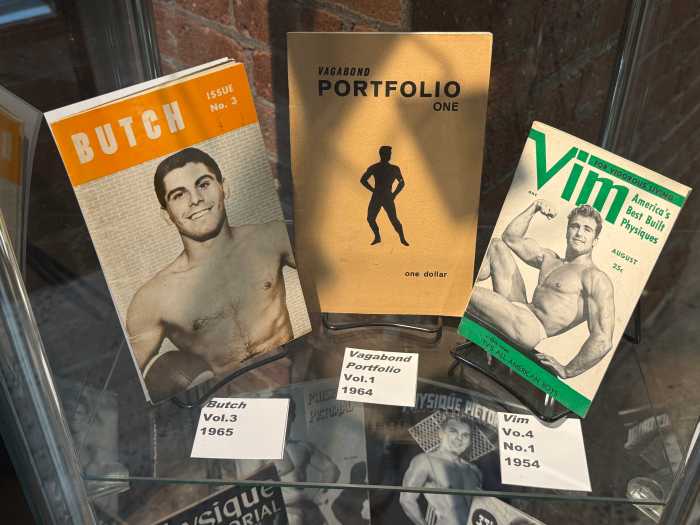“Two Wakashu, One Playing Shakuhachi” (1782), a color woodblock pillar print by Tori Kiyonaga (1752-1815). | ROYAL ONTARIO MUSEUM/ SIR EDMUND WALKER COLLECTION/ PHOTO BY BRIAN BOYLE
To enter Japan Society’s exquisite new exhibit, “A Third Gender: Beautiful Youths in Japanese Prints,” is to be swept back in time to the Edo Period (1603-1868) and the “floating world” (ukiyo), a universe of pure pleasure and escape from humdrum ordinary life, reflected in outlets like Kabuki theaters and red light districts. The exhibit, originally organized by the Royal Ontario Museum in Toronto, includes more than 70 images and objects and is the first in North America to focus on representations of wakashu and the attendant issues of mutable gender and sex in ancient Japan.
Wakashu refers to male youths during the years between their sexual maturation and their formal acceptance into adulthood, which is marked by the genpuku ceremony, in which both males and females received their adult name, hairstyles, and clothing (a samurai helmet for the boys, a pleated skirt for girls). Wakashu were deemed fitting sexual partners for both men and women and, with their distinctive, androgynous appearance, they constituted what many modern scholars consider a “third gender,” a concept some find resonance of in today’s widening range of LGBTQ identities.
The stereotypical view of Japanese people as repressed, even asexual, is given a severe rebuke by this show, which includes a designated “for mature viewers” section containing erotically charged prints depicting sexual couplings, although never in the nude — instead, always slightly camouflaged by the elaborate folds of a kimono. What gay content that exists here is subtle and coded, like the woodblock print “Two Wakashu, One Playing Shakuhachi [flute],” by Torii Kiyonaga (1752-1815), depicting two youths enjoying each other’s company, intensified by the secondary meaning of shakuhachi — the penis.
I do wish, since this show makes such a case for wakashu as being antecedents of today’s queer culture, that more contextual information had been given about homosexuality in Japan. It was very common in male Buddhist institutions, with pederastic relationships involving monks and boys as their acolytes. Outside the monastery, jokes were commonly made about monks’ predilection for male prostitutes. In Shintoism, some gods were even considered the guardian deities of nanshoku (male-male love).
Same-sex love spread to the samurai (warrior) class, where the custom was for a wakashu to undergo martial arts training from an adult male, and, if the boy agreed, the man could take him for his lover until he came of age. These were often even formalized by a contract, with both parties swearing to take no other male lovers. The sex was supposed to end when the boy came of age, with the hope that they would be lifelong friends and free to take on new wakashu partners. Adults were never permitted to take on a wakashu (traditionally passive) role, and only pre-adult men — or, sometimes, lower class men — were considered desirable.
Some prints on view depict scenes from the Kabuki theater, which was filled with wakashu and became a hotbed of sexual action among the middle class, with actors — some big stars in their own right — often working as prostitutes offstage. Males impersonating both females and young male roles were highly sought after by stage door johnnies of both sexes. Kabuki itself is generally thought to have been created by a woman, O-Kuni of Izumo, who first gathered a troupe of females ( some prostitutes) in 1603, for what are known as the first Kabuki plays. The women, of course, played both male and female parts. Soon enough, men got into the act, too, with the result that women were playing men’s roles, while men and wakashu were playing women. That ended in 1629, when women were banned altogether from the stage.
During the 17th century, certain male prostitutes and actors concealed their age, keeping their wakashu status well into their 20s or even 30s. Sometimes clients hired “boys” who were even older than themselves, leading in time to bans on the identifying forelocks traditionally sported by wakashu (along with a shaved patch of skull) in order to reduce confusion and curb this deceit.
Japan Society’s new show focuses on a 17th century’s so-called third sex
In terms of overt sexuality, the exhibit has far more images of wakashu with women, desirous of them, than men. In the print series “Woman and Wakashu,” circa 1790s, females are shown as the aggressors with wakashu, despite Confucian ideals that ruled that women were supposed to be passive. I wish more light had been shed here on this surprising and quite wonderful historical occurrence of female sexual empowerment in Japan, which is mostly noted, as far as women go, for the enduring mystique of the geisha, all passive obedience and veiled appearance and intentions.
“Geese Descending on the Koto Bridges from Eight Fashionable Parlour Views” (1768–1770), a color woodblock print by Suzuki Harunobu (1725–1770). | ROYAL ONTARIO MUSEUM/ SIR EDMUND WALKER COLLECTION/ PHOTO BY BRIAN BOYLE
In a page from “Book of Erotic Parodies” by Kitao Shigemasa (1739-1820), there is inscribed dialogue accompanying the sight of an older woman trysting with a wakashu:
She: Listen to what I am saying! Here, here! Wakashu: I just can’t do that sort of thing. She: Come on! You are such a tease!
Cross-dressing played a part in this world, as well, with males wearing feminine fripperies such as combs and transparent kimono, like the one seductively sported by a wakashu peddler in “Fan Seller,” my favorite print.
Other works depict women impersonating wakashu, as in “A Woman with a Shaved Patch” by Utagawa Kunisada (1786-1865), featuring a prostitute wearing the wakashu hairdo of forelock and shaved patch and a haori (man’s jacket) over her kimono to lure wakashu-loving clients. So great was the erotic appeal of wakashu that their appearance became fetishized.
“Two Couples in a Brothel” (1769–1770), a color woodblock print by Suzuki Harunobu (1725–1770). | ROYAL ONTARIO MUSEUM/ SIR EDMUND WALKER COLLECTION/ PHOTO BY BRIAN BOYLE
All the fun, however, came to a decided halt with the end of the Edo period and the Westernization of Japan, brought on by the arrival of American ships to this long closed-off country in 1853. The Meiji government, which took over until 1912, encouraged swift modernization, including the adoption of Western customs. Men were now strictly supposed to be men and women, women.
With all that binary gender structuring and heteronormative innovation, there was simply no place for the wakashu tradition, and so it ended.
“Wakashu and Young Woman with Hawks” (circa 1803), a color woodblock print by BunrÅ (active 1801–1804). | ROYAL ONTARIO MUSEUM/ PHOTO BY BRIAN BOYLE






































